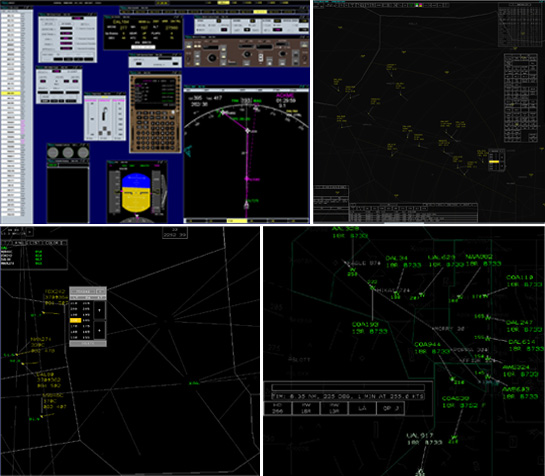|
|
 |

|
 |
 |
MACS is the principal software platform used in the AOL to provide an environment for rapid prototyping, human-in-the-loop air traffic simulations, and evaluation of current and future air/ground operations for the National Airspace System. The existing suite of capabilities allows researchers to configure a wide range of air traffic environments, from accurately emulating current-day operations to simulating many of the operations envisioned for NextGen as well as the transitional stages in between. MACS provides high-fidelity display emulations for air traffic controllers and managers as well as user interfaces and displays for confederate pilots and flight crew participants, airline dispatchers, and experiment managers, analysts, and observers. Scenario and target generation capabilities are also built into MACS, which are used to generate and run traffic problems tailored to the specified challenges of a research project. An integrated and flexible data collection system is used to collect the quantitative measures of interest at each operator station as well as overall traffic progression, including aircraft states, conflicts, and sector counts.
Currently MACS has air traffic control display emulations for the en route (DSR), TRACON (STARS), and oceanic (ATOP) domains. Emulating the vital aspects of the fielded controller's display behavior and supporting automation, combined with using the fielded controller keyboard, trackball and monitor to interact with, provide the controller participants with the backdrop for a very real simulation. Complementing the controller workstations are MACS' flight deck capabilities. Whether combined with a Cockpit Display of Traffic Information (CDTI), or used as a confederate pseudo-pilot, MACS can simulate current-day flight technologies to allow controllers to issue standard and non-standard clearances. Pilot workstations can be configured to either reflect the look of a modern glass cockpit emphasizing the correctness of the controls, or present generic input devices designed for quickly entering commands for multiple aircraft. Tying these air and ground sides together is an emulation of current-day communication, navigation and surveillance technologies, which provides the appropriate system response to controller instructions.
One of the design goals in the AOL is to provide the required functionality to investigate a specific operational concept early in its life cycle. MACS is a research tool only, and is not intended to be integrated into the operational air traffic system. This relaxes several constraints, while adding significant flexibility to the software. MACS builds on its accurate emulation of current-day systems and provides an infrastructure primed for rapid prototyping. Its object-oriented architecture makes reusing existing components in different ways quite simple, and also allows for the addition of new functions by extending only a few common classes. MACS is built entirely in JAVA, and is developed and implemented by the AOL development team.

(Click image to view full-size jpeg- 274KB)
Point of Contact: Joey Mercer, M.S., Human Systems Integration Division, NASA Ames Research Center |
|
|